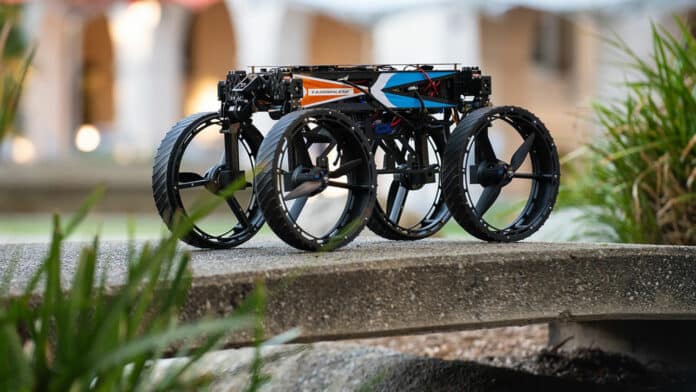The advancements in robotics and artificial intelligence (AI) over the past decade have allowed a surprising evolution of robots that are now more intelligent and versatile. Engineers draw a lot of inspiration from nature for ideas on how to make robots move through the world.
Taking inspiration from animals like chukar birds, meerkats, and walruses, engineers have designed a real-life Transformer capable of reconfiguring its body to drive, fly, and walk to meet the needs of the moment.
The new robot, the Multi-Modal Mobility Morphobot (M4), can roll on four wheels and flip them into rotors to fly or transform for six other types of motion. It can stand on two wheels to peer over obstacles, walk by using its wheels like feet, use two rotors to help it roll up steep slopes on two wheels, tumble, and more.
Thanks to this, M4 can move in a wide range of ways to adapt and navigate diverse environments: whether it is flying, rolling, crawling, crouching, tumbling, balancing, or cartwheeling. The findings could enhance the design of robots used in a broad number of applications, including search and rescue operations after natural catastrophes – such as earthquakes, floods, or windstorms, space exploration, automated package handling in residential spaces, and digital agriculture.
The M4 is the brainchild of Mory Gharib, a professor of aeronautics and bioinspired engineering at Caltech, and Alireza Ramezani, an assistant professor of electrical and computer engineering at Northeastern University.
The robot has four legs, each comprising two joints and ducted fans fixed at the leg ends. The robot weighs approximately 6.0 kg with all components, including the onboard computers for low-level control and data collection, sensors, communication devices for teleoperation, joint actuators, propulsion motors, power electronics, and batteries. It measures 0.7 m in length and 0.35 m in both width and height when in UGV mode.
The Morphobot showcases its versatility through its unique fan design – the fans can seamlessly transition between serving as legs, propeller thrusters, or wheels. The chassis structures and shrouded propeller components in M4 were primarily made of carbon fiber and 3D-printed parts.
The M4 is equipped with onboard computers and sensors and can make decisions for itself about how best to navigate through a complex environment. When exploring an unfamiliar environment, the M4 might start by rolling along on four wheels, which is its most energy-efficient mode. When it sees another feature that a wheeled robot could not traverse, it could reconfigure its wheels into rotors, fly over the ravine to the other side, and resume rolling along.
Moreover, the configuration with two wheels and two propellers can help it climb steep slopes. M4 can traverse steep slopes of up to 45 degrees and rough terrains with large obstacles when in balancing mode.
When the Morphobot needs to stand up on two wheels, two of its four wheels fold up, and their inset propellors spin upwards, providing balance for the robot. In the flying mode, all four wheels fold up, and the propellors lift the robot off the ground.
“Our aim was to push the boundaries of robot locomotion by designing a system that showcases extraordinary mobility capabilities with a wide range of distinct locomotion modes. The M4 project successfully achieved these objectives,” says Ramezani, corresponding author of the paper.
Journal reference:
- Eric Sihite, Arash Kalantari, Reza Nemovi, Alireza Ramezani and Morteza Gharib. Multi-Modal Mobility Morphobot (M4) with appendage repurposing for locomotion plasticity enhancement. Nature Communications, 2023; DOI: 10.1038/s41467-023-39018-y
